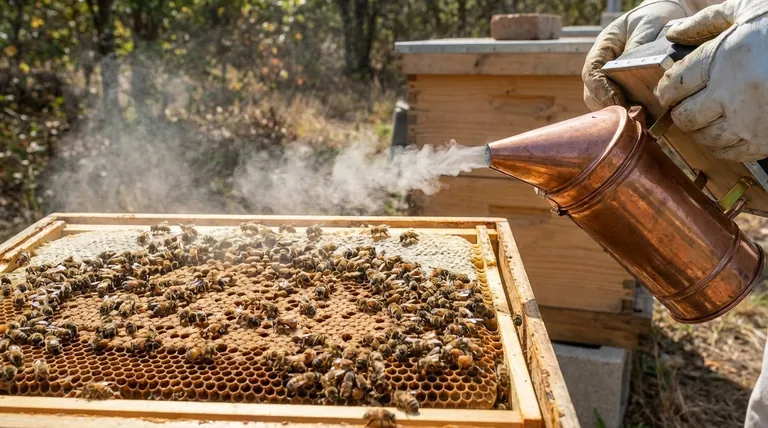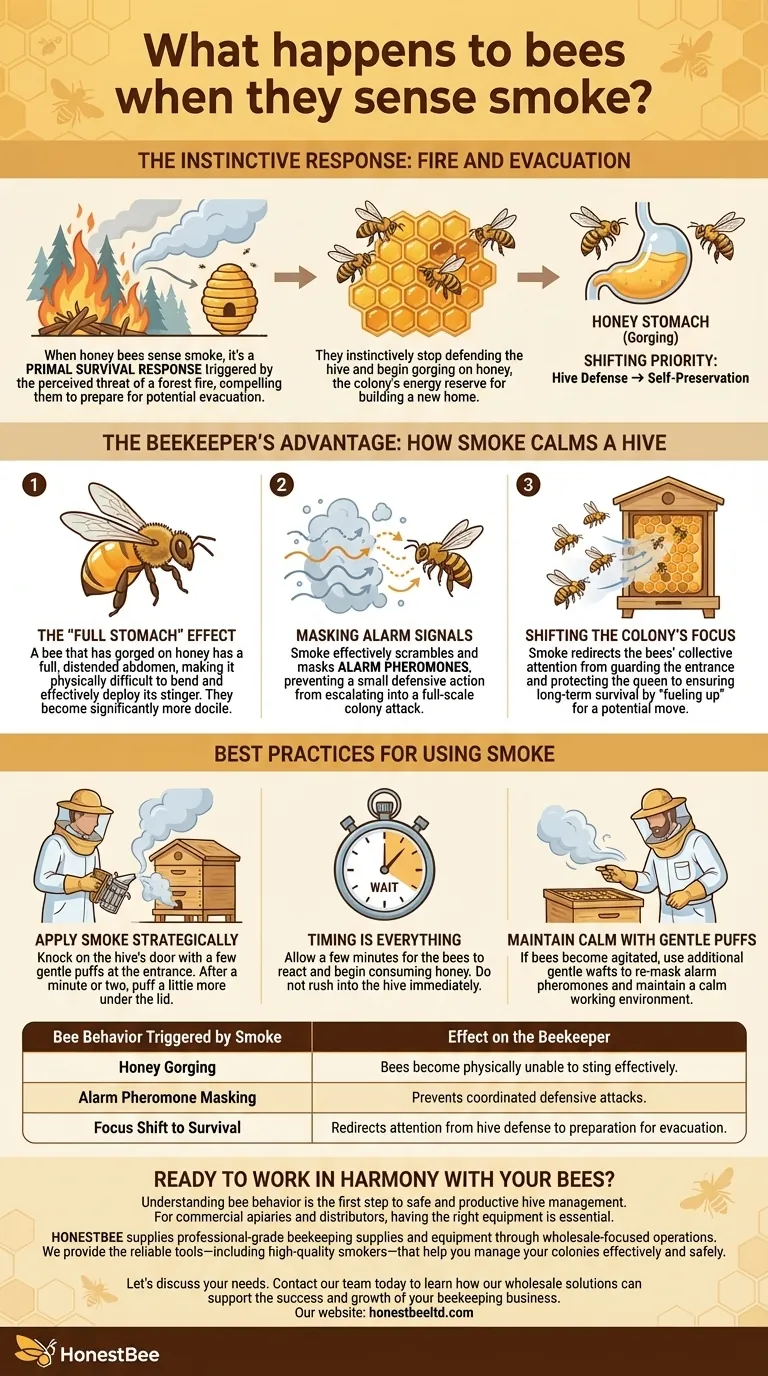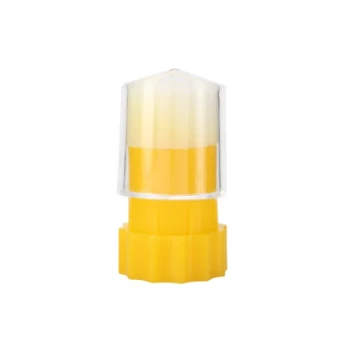When honey bees sense smoke, their behavior changes dramatically and immediately. They instinctively stop defending the hive and begin gorging themselves on honey, filling a special internal organ called a "honey stomach." This is a primal survival response triggered by the perceived threat of a forest fire, compelling the bees to prepare for a potential evacuation.
The core principle to understand is that smoke doesn't sedate bees, but rather exploits their natural instincts. It shifts their priority from hive defense to self-preservation, making them physically less able to sting and chemically unable to coordinate an attack.

The Instinctive Response: Fire and Evacuation
To bees, the smell of smoke is a deeply ingrained signal of danger. It represents one of the greatest threats to their colony in the wild: a forest fire that could destroy their home and resources.
A Primal Trigger
For millions of years, fire has been a destructive force of nature. Bees have evolved a specific, non-negotiable protocol for this exact scenario. Smoke is the trigger for that protocol.
Preparing for the Worst
Upon sensing smoke, worker bees rush to the nearest open honey cells. They begin to rapidly consume and store as much honey as possible in their honey stomach.
Fueling a New Home
This behavior is not about simple hunger. The honey they consume is the colony's energy reserve, a vital resource they would need to build a new wax comb and establish a new home if forced to abandon the old one.
The Beekeeper's Advantage: How Smoke Calms a Hive
Beekeepers have understood this instinctive reaction for centuries. The use of a smoker is not an act of aggression but a clever manipulation of the bees' natural behavior to allow for safe hive inspections.
The "Full Stomach" Effect
A bee that has gorged on honey has a full, distended abdomen. This physical state makes it difficult for the bee to bend its body into the proper angle required to effectively deploy its stinger. This makes them significantly more docile.
Masking Alarm Signals
When a bee stings, it releases an alarm pheromone. This chemical signal acts as a beacon, alerting other guard bees to the location of the threat and inciting them to attack the same spot. Smoke effectively scrambles and masks these pheromones, preventing a small defensive action from escalating into a full-scale colony attack.
Shifting the Colony's Focus
Ultimately, the smoke redirects the bees' collective attention. Their minds shift from guarding the entrance and protecting the queen to ensuring the long-term survival of the colony by "fueling up" for a potential move.
Best Practices for Using Smoke
Understanding the why behind the bees' reaction is critical to using smoke effectively and humanely. The goal is communication, not brute force.
Apply Smoke Strategically
A beekeeper "knocks" on the hive's door with a few gentle puffs of smoke at the entrance. After a minute or two, they puff a little more under the lid before opening it. This gives the bees time to sense the "threat" and begin feeding.
Timing is Everything
The calming effect is not instantaneous. You must allow a few minutes for the bees to react to the smoke and begin consuming honey. Rushing into the hive immediately after applying smoke is a common mistake.
Maintain Calm with Gentle Puffs
During an inspection, if bees start to become agitated or restless, a few additional gentle wafts of smoke can re-mask alarm pheromones and maintain a calm working environment. It can also be used to physically direct bees away from an area you need to work on.
Making the Right Choice for Your Goal
Applying this knowledge correctly is the difference between a stressful inspection and a peaceful one.
- If your primary focus is routine inspection: A few gentle puffs at the entrance and under the lid before you begin are all that's needed to trigger the honey-gorging response.
- If you are dealing with an agitated hive: Use smoke to interrupt the alarm cycles and mask the pheromones that are triggering the defensive chain reaction.
- If you need to move bees physically: Waft smoke in a specific direction to gently herd bees away from the edges of the hive box without harming them.
Understanding this behavior is the key to working in harmony with your bees, ensuring safety for both you and the colony.
Summary Table:
| Bee Behavior Triggered by Smoke | Effect on the Beekeeper |
|---|---|
| Honey Gorging | Bees become physically unable to sting effectively. |
| Alarm Pheromone Masking | Prevents coordinated defensive attacks. |
| Focus Shift to Survival | Redirects attention from hive defense to preparation for evacuation. |
Ready to Work in Harmony with Your Bees?
Understanding bee behavior is the first step to safe and productive hive management. For commercial apiaries and distributors, having the right equipment is essential.
HONESTBEE supplies professional-grade beekeeping supplies and equipment through wholesale-focused operations. We provide the reliable tools—including high-quality smokers—that help you manage your colonies effectively and safely.
Let's discuss your needs. Contact our team today to learn how our wholesale solutions can support the success and growth of your beekeeping business.
Visual Guide

Related Products
- Premium Traditional Copper Bee Smoker with Bellows
- Stainless Steel Honey Bee Smoker Hive and Honeycomb Smoker for Beekeeping
- European Stainless Steel Bee Smoker for Honey Bee Hive
- Stainless Steel Bee Hive Smoker Beekeeping Smoker for Wholesale
- Stainless Steel Electric Beehive Smoker for Beekeeping and Bee Keeper Use
People Also Ask
- What are the main parts of a bee smoker? Essential Components for Calm Hive Management
- What are some alternatives to using smoke in beekeeping? A Guide to Gentle Hive Management
- How did early beekeepers use bee smokers? Master Ancient Bee Calming Techniques
- What is the purpose of a bee smoker and how should it be used? A Guide to Calm, Safe Hive Inspections
- What is a Smoker and how is it used in beekeeping? The Essential Tool for Calm, Safe Hive Inspections



















